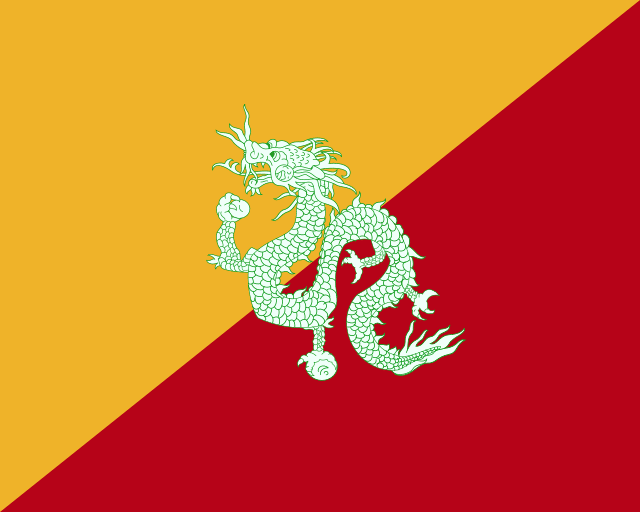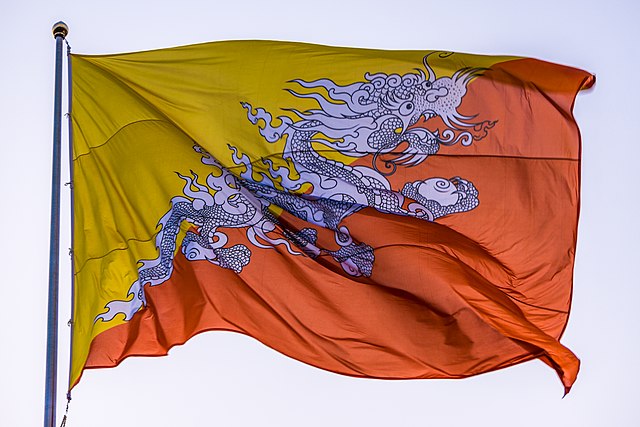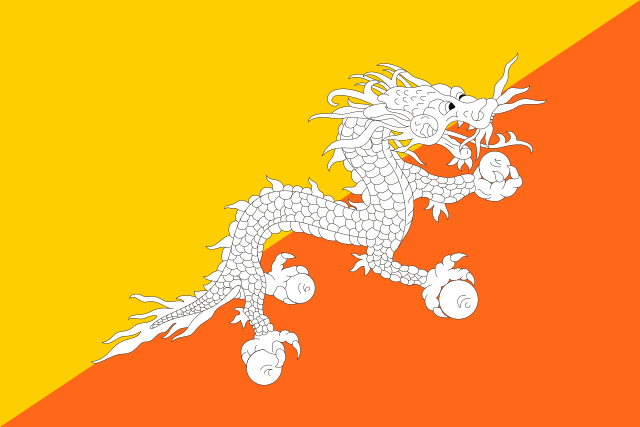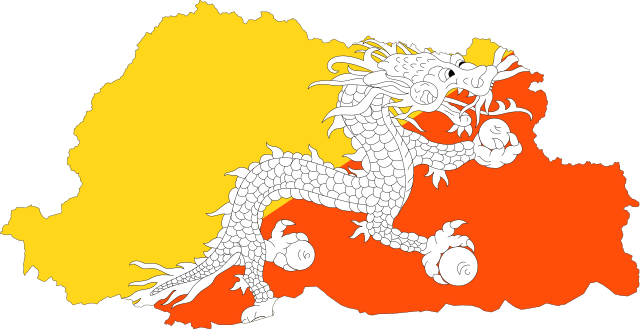Bhutan is a tiny, predominantly Buddhist country sandwiched between China and India. It is surrounded by dense forests and is cut by steep ravines. The Bhutan flag is a striking representation of the country’s distinctive history and culture.
If you want to learn more about the Bhutan flag, its significance, history, and symbolism, then this article will provide all the essential information.
Where Is Bhutan Located?
Before exploring the history and symbolism of the Bhutan flag, let’s learn more about the country’s geographic location. In south-central Asia, among the high ridges of the eastern Himalayas, is the tiny nation of Bhutan. Its geographic isolation from China’s Tibet Autonomous Region to the north and India’s east, south, and west lend it important geopolitical significance.
Because of the rough, snow-covered mountains in the north and the deep, humid jungles in the south, as well as the choices of its rulers, it had long been cut off from the rest of the world’s concerns. Time in Bhutan is compatible with UTC +6.
Bhutan is currently in a position of tension between the ancient and the modern. With care taken to protect its traditional culture and pristine natural environment, it has started to modernize and open the nation to outside influences.
History Of Bhutan
The Bhutan flag has undergone several changes over time. The history of the country is intertwined with the flag’s development milestones. Therefore, it is essential to overview the brief history of Bhutan. has had various names throughout history. The Bhutanese nonetheless refer to their nation as Druk, meaning dragon. Among other names, Druk was chosen in 1189 for the nation because of its historical significance. Religion has had a major effect on Bhutan’s history.
Bhutan’s written history dates back to the ninth century when Tibetan monks fled unrest in their home country and settled there. Throughout most of its history, Bhutan’s many religious institutions have been a significant source of influence. In the 12th century, the Drukpa Kagyu school of Buddhism was founded. In Bhutan, it is still the predominant branch of Buddhism.
Up until Ngawana Namgyal assumed control in 1616, a variety of religious schools continued to dominate Bhutan. He assumed the title of Shabdrung or ruler. At this time, the nation was harmonious and governed by a single body of law. It took 200 years after Ngawana’s passing for the next legendary king to come to power.
Following his passing, internal strife and civil conflict reduced the shabdrung’s authority until Ugyen Wangchuck was able to solidify control and develop deeper links with the British in India in 1885. Diplomatic relations with India were established by Ugyen and later by his son Jigme. Bhutan signed a Treaty of Peace and Friendship with India in 1949 after gaining independence in 1947.
History Of Bhutan Flag
The First National Flag
The Bhutan flag was created in 1947 at the nation’s ruling family’s request. The flag, which depicts Druk, the Thunder Dragon from Bhutanese mythology, is based on the Drukpa Lineage of Tibetan Buddhism. The Mayum Choying Wangmo Dorji flag’s fundamental layout dates to 1947. A replica was on exhibit in 1949 when the Indo-Bhutan Treaty was signed.
It originally gained international attention during negotiations between Bhutan and India. The original flags from this period have all since been lost, although descriptions have been kept. The dragon was a lighter shade of green than the current black-and-white design, but they were very similar. In addition, the field had a red area in place of the contemporary orange area.

Modernized Bhutan Flag
In 1956, a modernized version of the design entered use. It was for Druk Gyalpo Jigme Dorji Wangchuk’s tour to eastern Bhutan in 1956. It was based on photographs of its 1949 predecessor and substituted a white Druk for the green one in the first. The black and white pattern with the green dragon on the front was replaced.
The Bhutanese monarch traveled the whole length of his nation while flying this flag. A duplicate of the flag was placed in every tenth pony’s saddle when he was traveling with a huge group of ponies. Every time he stopped at night, the Bhutan flag was also flying.

Current Bhutan Flag
Although the precise introduction date of this flag is uncertain, it may have happened in 1971, the year Bhutan joined the UN. Bhutan was mainly isolated from the outside world until the 1960s. Its international affairs had been handled by both the United Kingdom (1910–1949) and India. (from 1949 to the 1960s). The conditions under which a national flag was necessary were strongly circumscribed by Bhutan’s remoteness and absence of a seacoast.
In 1969, the new flag was adopted. The flag was altered to have improved visual appeal as it moved in the breeze. The Bhutanese then modified their flag to match the dimensions of the Indian flag, which they thought was superior to their own. The present national flag was created after further alterations, such as changing the red background hue to orange. To prevent it from facing the ground while the flag was limp, the dragon’s form was also altered.
In order to standardize the design of the flag, the procedure for permissible flag sizes was defined. Additionally, the circumstances under which the flag may be flown were set by the National Assembly of Bhutan code of conduct in 1972.

Design Of Current Bhutan Flag
The top triangle of the present flag is yellow, while the lower triangle is orange, and they are separated diagonally from the lowest hoist-side corner. A huge black and white dragon stands in the center of the divide, looking away from the hoist side. The dragon’s claws are each cradling a thunderbolt or a diamond. Pantone colors 116 and 165, respectively, are used for the flag’s yellow and orange backgrounds.
Symbolism Of Bhutan Flag
The nation’s Buddhist heritage is symbolized by the orange portion of the Bhutan flag. The monarchy’s authority and strength in the material world are symbolized by the yellow part, which is taken from the King of Bhutan’s traditional attire.
Bhutan is known as the “Land of the Thunder Dragon” in its native tongue because of its long-standing belief that the thunder in its many mountains and valleys is the voice of dragons.
To highlight the equal importance of the nation’s Buddhist past and the state’s strength in the present country, a dragon is placed in the middle of the flag. The dragon on the flag holds gems in its claws as a symbol of national prosperity and excellence. The dragon, which was once green but is now white, stands for purity and the allegiance of the nation’s many ethnic groups.

Code Of Conduct – National Flag Rules
The National Assembly of Bhutan adopted Resolution 28 on June 8th, 1972, putting the National Flag Rules created by the Cabinet into force. The flag’s colors, fields, and design components are described, along with their meanings, under eight sections of the regulations. Other guidelines include flag procedure, including how big the flag should be, where and when it should be flown, and who is allowed to fly it on vehicles.
Generally speaking, the flag is treated with the same reverence as the Bhutanese state and its head of state. The Bhutan flag cannot, with limited restrictions, be used as a cover or drape, cannot touch the ground, and no other flags may be flown higher than it, according to the Flag Code.
The 1972 regulations further state that “every dzongkhag (district administrative center) would raise the flag of the country.” In areas without a dzongkhag, the national flag shall be flown in front of the chief government official’s office. Ministers and above are permitted to display the flag at home, provided they don’t dwell close to the capital.
Bhutan did not have a custom of flying the national flag in front of government buildings until 1968 when the Druk Gyalpo ordered it to be done as a matter of course after moving his secretariat from the city of Taba to Tashichho Dzong. The sole flag day included in the regulations from 1972 is National Day, which is celebrated on December 17th. National Day honors the coronation of Ugyen Wangchuck as Bhutan’s first king on December 17, 1907.
Coat Of Arms Of Bhutan
The double diamond thunderbolt (Dorje), which is positioned centrally on a lotus flower and is flanked on either side by two standing dragons, is the focal point of Bhutan’s national crest. It is enclosed inside a circle.
The lotus blossom denotes purity, the thunderbolt depicts harmony between secular and religious forces, and the gem perched atop expresses absolute power. The two dragons represent the nation’s name, which they announce with a resounding voice.
Bottom Line
The Bhutan flag is among the most beautiful and unique flags in the world. One of the first versions dates back to 1947 and has undergone several changes over the decades. The flag’s symbolism stems from a far earlier history that precedes the contemporary nation.
Since the country’s ancient mythology dates back hundreds of years, the dragon has served as a symbol of Bhutan and its people, which is also presented on the current Bhutan flag.